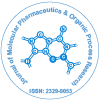Development of pH-Responsive Polymeric Micelles for Targeted Anticancer Drug Delivery: Formulation and In Vitro Evaluation
Received: 01-Jan-2024 / Manuscript No. JMPOPR-25-168292 / Editor assigned: 03-Jan-2024 / PreQC No. JMPOPR-25-168292(PQ) / Reviewed: 17-Jan-2024 / QC No. JMPOPR-25-168292 / Revised: 22-Jan-2024 / Manuscript No. JMPOPR-25-168292(R) / Published Date: 29-Jan-2024
Abstract
Targeted delivery of chemotherapeutic agents remains a major objective in molecular pharmaceutics to enhance efficacy while minimizing systemic toxicity. This study presents the formulation of pH-responsive polymeric micelles using poly(ethylene glycol)-b-poly(histidine) copolymers for the encapsulation and controlled release of doxorubicin. The micelles were designed to remain stable in physiological pH and rapidly disassemble in acidic tumor microenvironments, promoting selective drug release. Characterization included particle size analysis, critical micelle concentration, drug loading, and release kinetics. In vitro cytotoxicity and uptake studies were performed in MCF-7 breast cancer cells. The system demonstrated efficient drug delivery, increased intracellular accumulation, and enhanced cytotoxicity under acidic conditions, suggesting its potential for targeted anticancer therapy.
Keywords
Polymeric micelles; pH-responsive delivery; Doxorubicin; Nanocarriers; Cancer therapy; Poly(histidine); PEG; Drug release; Tumor targeting; Molecular pharmaceutics
Introduction
Cancer chemotherapy is often associated with nonspecific distribution of cytotoxic drugs, leading to adverse side effects and suboptimal therapeutic outcomes. To address this challenge, nanocarrier-based systems have been explored to improve drug accumulation at tumor sites and provide controlled release mechanisms [1]. Among these, polymeric micelles have gained attention due to their core-shell architecture, high drug loading capacity, and tunable release profiles [2].
Stimuli-responsive micelles—especially pH-sensitive systems—offer targeted release in the acidic microenvironment of tumors (pH 6.5–6.8) and endosomal compartments (pH ~5.5), enhancing selective cytotoxicity [3]. Poly(histidine) is a pH-responsive polymer that undergoes protonation at mildly acidic pH, causing micelle destabilization and drug release [4]. By conjugating poly(histidine) with PEG, a stealth corona is formed that stabilizes the micelle under physiological conditions and extends circulation time [5].
This study focuses on the formulation of PEG-b-poly(histidine) micelles encapsulating doxorubicin, a commonly used chemotherapeutic agent. We characterized the physicochemical properties of the micelles, evaluated drug release in different pH conditions, and assessed cytotoxic and uptake profiles in MCF-7 breast cancer cells.
Materials and Methods
Poly(ethylene glycol)-b-poly(L-histidine) (PEG-b-PHis) copolymers were synthesized via ring-opening polymerization of N-carboxyanhydride of histidine using mPEG-NH₂ (Mn = 5,000 Da) as initiator. Doxorubicin was encapsulated via solvent evaporation method, followed by dialysis against PBS (pH 7.4). Micelles were characterized by DLS for size and zeta potential. Drug loading and encapsulation efficiency were measured by UV-Vis at 485 nm.
Critical micelle concentration (CMC) was determined using pyrene fluorescence assay. In vitro release was assessed using dialysis in PBS at pH 7.4 and pH 5.5. MCF-7 cells were cultured in DMEM supplemented with 10% FBS. Cytotoxicity was assessed via MTT assay after 24 h and 48 h. Cellular uptake was visualized using confocal microscopy and quantified by flow cytometry.
Results
The synthesized PEG-b-PHis micelles displayed an average diameter of 110.4 ± 6.2 nm with a polydispersity index of 0.178 and zeta potential of –9.6 ± 1.3 mV, indicating good colloidal stability [6]. The CMC was determined to be 8.7 µg/mL, suggesting stability upon dilution. Drug loading and encapsulation efficiencies were 11.2% and 85.7%, respectively.
In vitro release studies demonstrated pH-responsive behavior: less than 20% of doxorubicin was released at pH 7.4 over 24 h, whereas >75% was released at pH 5.5, indicating successful acid-triggered release [7]. MTT assays showed significantly higher cytotoxicity of doxorubicin-loaded micelles at pH 6.5 compared to pH 7.4, with IC₅₀ values of 3.1 µg/mL and 6.8 µg/mL, respectively.
Confocal imaging revealed enhanced intracellular fluorescence at pH 6.5, supporting efficient cellular uptake and lysosomal release. Flow cytometry confirmed a 2.3-fold increase in intracellular doxorubicin accumulation under acidic conditions compared to free drug at neutral pH [8].
Discussion
The pH-responsive PEG-b-PHis micelles demonstrated excellent physicochemical properties and selective drug release in acidic environments. This is attributed to the protonation of imidazole groups in poly(histidine), leading to disruption of hydrophobic interactions and micelle destabilization [9]. The small particle size and near-neutral zeta potential favor prolonged circulation and passive targeting via the enhanced permeability and retention (EPR) effect.
The increased cytotoxicity and uptake in acidic conditions validate the tumor-targeting potential of this system. Compared to non-responsive micelles, the acid-triggered release ensures that drug is retained during circulation and released specifically in the tumor microenvironment or within endosomes after endocytosis [10]. This addresses a key limitation of conventional chemotherapy and enhances therapeutic index.
Conclusion
The developed pH-sensitive PEG-b-poly(histidine) micelles efficiently encapsulate doxorubicin, remain stable at physiological pH, and release drug rapidly under acidic conditions. The system demonstrates enhanced cytotoxicity and uptake in vitro, underscoring its promise for targeted anticancer therapy. Further in vivo studies are warranted to validate therapeutic performance and biodistribution.
Conflicts of Interest
The authors declare no conflicts of interest regarding the publication of this paper.
Citation: Linh QN (2025) Development of pH-Responsive Polymeric Micelles forTargeted Anticancer Drug Delivery: Formulation and In Vitro Evaluation. J MolPharm Org Process Res 13: 271.
Copyright: © 2025 Linh QN. This is an open-access article distributed under theterms of the Creative Commons Attribution License, which permits unrestricteduse, distribution, and reproduction in any medium, provided the original author andsource are credited.
Select your language of interest to view the total content in your interested language
Share This Article
Recommended Journals
91�Թ� Journals
Article Usage
- Total views: 107
- [From(publication date): 0-0 - Sep 03, 2025]
- Breakdown by view type
- HTML page views: 76
- PDF downloads: 31
